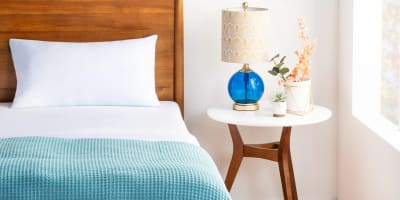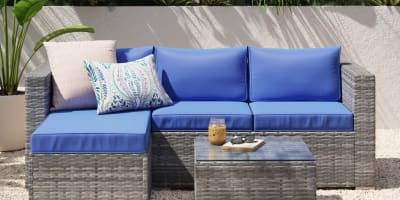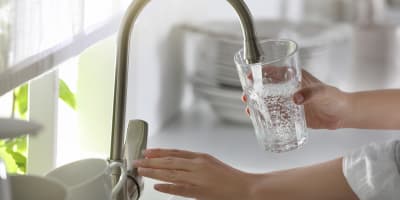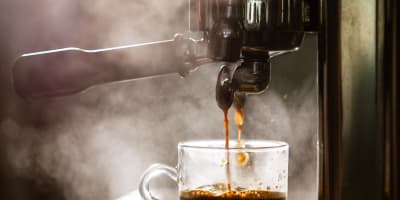We may earn commission from links on this page, but we only recommend products we believe in. Pricing and availability are subject to change.
The best skin care routine for your 50s, according to dermatologists
I've been writing about skin care for nearly a decade, and while the anti-aging trends come and go, the advice I hear from the experts stays the same: Hydrate, wear sunscreen and target problem areas at the first sign. But even if their advice is solid, most women don't begin to notice the more dramatic signs of aging until perimenopause, when hormonal changes begin to take hold both inside and out.
CeraVe Hydrating Facial Cleanser
Best overall face wash
La Roche-Posay Toleriane Hydrating Gentle Face Cleanser
Best barrier-boosting face wash
Thayers Alcohol-Free Witch Hazel Toner (Unscented)
Best overall toner
SON & PARK Beauty Water
Best gentle exfoliating toner
Klaris Supple Preparation Toner (Unscented)
Best gentle hydrating toner
THE ORDINARY Hyaluronic Acid 2% + B5
Best hyaluronic acid serum
SkinCeuticals C E Ferulic
Best vitamin C serum
Cetaphil Healthy Renew Retinol Alternative Peptide Serum
Best peptide serum
Neutrogena Rapid Wrinkle Repair Retinol Face Moisturizer
Best overall retinol moisturizer
THE ORDINARY Granactive Retinoid 2% Emulsion
Best gentle retinoid serum
La Roche-Posay Redermic R Anti-Aging Retinol Cream
Best exfoliating retinol cream
PCA Skin Intensive Age Refining Treatment
Best targeted retinol serum
RoC Retinol Correxion Under Eye Cream
Best overall eye cream
SkinCeuticals A.G.E Advanced Eye Cream
Best caffeine eye cream
Perricone MD Smoothing & Brightening Under-Eye Cream
Best brightening eye cream
Olay Regenerist Micro-Sculpting Cream
Best (budget) overall moisturizer
Charlotte Tilbury Magic Cream Moisturizer with Hyaluronic Acid (1 ounce)
Best (splurge) overall moisturizer
La Roche-Posay Toleriane Double Repair Face Moisturizer
Best lightweight moisturizer
SkinCeuticals Triple Lipid Restore 2:4:2
Best deep hydration moisturizer
Neutrogena Ultra Sheer Dry-Touch Water Resistant Sunscreen
Best overall sunscreen
La Roche-Posay Anthelios Mineral Ultra-Light Sunscreen SPF 50
Best mineral sunscreen
EltaMD UV AOX Elements Broad-Spectrum SPF 50
Best tinted face sunscreen
Paula's Choice Advanced Smoothing Treatment 10% AHA Serum
Best overall exfoliant
La Roche-Posay Glycolic Acid Serum
Best exfoliating serum
Biossance Squalane + 10% Lactic Acid Resurfacing Serum
Best hydrating exfoliant
Solawave 4-in-1 Radiant Renewal Wand
Best (budget) red light device
Dr. Dennis Gross DRx SpectraLite Dpl FaceWare Pro
Best (splurge) red light device
NuFACE Trinity Starter Kit
Best facial toning device
Your 50s can be an especially complex time in your life, especially if you're experiencing menopause and all of the hormonal, mental, emotional and physical baggage that comes along with it. It's also the decade where much of your lived life begins to show up on your face, especially thanks to the plethora of changes going on below the surface of your skin. "The rapid drop in estrogen that occurs during perimenopause is a significant contributor to skin aging," said Dr. Hadley King, dermatologist and clinical instructor of Dermatology at the Weill Medical College of Cornell University. "This leads to reduced hydration and compromised barrier function, loss of elasticity and resiliency."
The good news? You still have time to begin targeting those early signs of aging in your 50s when you first spot them, unlike in your 60s when it's often too late to reverse any of those signs of aging. Whether you're noticing new dark spots or more pronounced wrinkles and sagging skin, all of the hormonal changes you're going through could mean that your skin care routine needs an overhaul to tackle your skin's new normal.
To help you find the best products for your lifestyle and budget, I spoke with eight dermatologists and skin care experts about how menopause affects the skin, what ingredients are best for aging skin and how to build a skin care routine that actually works for your needs. There's a lot to dig into, so we'll jump right in.
In this article: Face Wash | Toners | Serums & Treatments | Retinoids | Eye Creams | Moisturizers | SPF | Chemical Exfoliators | Skin Care Devices
How does your skin change in your 50s?
Menopause has a huge impact on your body. Not only are hormonal changes impacting you from the inside, but your skin is undergoing profound changes as well.
"Oh man, it really changes," said Dr. Ashley Magovern of Manhattan Dermatology and resident dermatologist for Dermstore. "In particular, estrogen decreases, which causes a decrease in oil production and leads to skin dullness and dryness, which leads to texture changes and the loss of that 'glow,'" she said. "I’ve found that even using lights, lasers, skincare products, it becomes harder and harder to restore that glow without that estrogen."
The loss in estrogen due to menopause causes decreased skin elasticity, hydration, oil production, collagen production and even thickness. As skin thins, the fat pads within the face also diminish, which can highlight wrinkles, accentuate sagging skin and lead to a "hollowed look," according to Dr. Ahmad Chaudhry, dermatologist at Scandinavian Biolabs. If that wasn't enough, all of these hormonal changes can even trigger increased melanin production during menopause, which causes dark spots and blotchiness.
All of these changes can mean that the products and skin care routine that you might've stood behind for years may no longer work for you as you enter your 50s and beyond.
"Reevaluating your skin care in your 50s is all about adapting to your skin's evolving needs, ensuring that it stays healthy, protected and nourished," said Lindsay Holdorf, resident esthetician at Dermstore. "These changes mean that skin care products and routines that worked well in earlier decades might no longer be as effective."
What changes should you make to your skin care routine in your 50s?
All of the experts we spoke with agreed that transitioning your skin care routine for your 50s is all about hydration and investing in target treatments for your changing skin's specific needs. Swapping to hydrating cleansers, using moisture-boosting serums, and investing in stronger anti-aging ingredients like retinoids, niacinamides and ceramides should become a priority.
"As skin concerns become more pronounced, it's essential to incorporate targeted treatments to address issues such as loss of firmness, hyperpigmentation and dryness," said Dr. T. N. Rekha Singh, dermatologist at Oliva Skin and Hair Clinic.
Another important change to think about? Paying more attention to your nighttime routine generally. "I know we are all tired at night and sometimes find excuses to skip the nighttime routine, but it becomes even more important as you age," Dr. Magovern said. "Our skin regenerates, restores and repairs itself at night, so giving it all the nutrients it needs is critical."
What skin care ingredients should you look for in your 50s?
Hyaluronic acid: A hydrating and plumping ingredient that draws in moisture and prevents moisture loss
Retinoids: Potent anti-aging ingredients that increase cell turnover, boost collagen production and reduce the appearance of fine lines, wrinkles and age spots
Peptides: AKA amino acids that support proteins in the skin like collagen and elastin, which are needed for firmness and elasticity
Niacinamide: AKA vitamin B3, which improves skin's elasticity, increases barrier function and tackles hyperpigmentation
Ceramides: Lipid molecules that strengthen the skin’s barrier and prevent moisture loss
AHAs: Chemical exfoliants, typically made of lactic acids or glycolic acids, that gently slough away dead skin and encourage new cell turnover for improved tone and texture
BHAs: Chemical exfoliants, typically salicylic acid, that gently slough away dead skin and encourage new cell turnover for improved tone and texture
Antioxidants: Vitamins C, E and ferulic acid, among others, that aid in protecting the skin from environmental damage, brighten skin and promote collagen production
SPF: Sun protection, arguably the most important ingredient in your skin care routine to prevent the noticeable signs of aging such as wrinkles, fine lines and discoloration
Fortunately, there are several proven powerhouse ingredients — and products! — that dermatologists and skin care experts agree should be part of your arsenal as you build an anti-aging skin care routine. Take a look at their recommendations below.
Face Wash & Cleansers
Texture: Thick, hydrating gel | Ingredients: Hyaluronic acid, ceramides | Other benefits: Fragrance-free, non-comedogenic
You'll want to start your skin care routine with a gentle, hydrating facial cleanser like CeraVe's Hydrating Facial Cleanser, which was recommended by several experts I spoke with. Because skin undergoes many changes in your 50s, experts agree that the hyaluronic acid and ceramides found in this cleanser are essential for gently cleansing away impurities while leaving skin hydrated and plump while retaining its natural oils.
If your skin feels tight after cleansing, then your face wash is likely too aggressive and might be stripping too many of your skin's precious oils. Consider cleansing your face only at night if your skin feels too dry in the morning for a second cleanse.
Texture: Thick, hydrating gel | Ingredients: Niacinamide, ceramides | Other benefits: Oil free, fragrance free, paraben free, sulfate free
Niacinamide — the technical name for vitamin B3 — is a well-known ingredient that's essential for improving skin elasticity, increasing barrier function and evening out skin tone. Ceramides are lipid molecules that increase hydration and prevent moisture loss. When combined, these two powerhouse ingredients target several of the biggest skin concerns in your 50s, according to Holdorf.
"As the skin produces less oil in your 50s, it becomes drier and may be more sensitive," she said. "Look for hydrating cleansers and moisturizers that contain hyaluronic acid, glycerin and ceramides. These ingredients help to maintain moisture without irritating the skin."
Toners
Texture: Watery liquid | Ingredients: Witch hazel, aloe | Other benefits: Alcohol free
A gentle toner should be used immediately after cleansing to prepare your skin for your serums and moisturizer. Hydrating toners are an important part of your skin care routine, especially as you age. But forget the drying, alcohol-heavy toners of your youth. Instead, reach for gentle toners with non-stripping ingredients like witch hazel and aloe to restore any moisture removed during cleansing, even out your skin tone, remove any lingering impurities and prepare your skin for the next part of your routine.
Because menopause can exacerbate symptoms like dryness, dehydration and discoloration, Dr. Chaudhry recommends Thayers Alcohol-Free Witch Hazel Toner.
Texture: Watery liquid | Ingredients: Witch hazel, rose water, lavender extract, orange fruit extract, antioxidants | Other benefits: Gently exfoliating, alcohol free
For a toner that both hydrates and gently exfoliates, Dr. Chaudhry recommends Son & Park Beauty Water. It's a multipurpose toner that acts as the final line in your cleansing routine to hydrate, exfoliate, refresh and prepare skin for your serums, treatments and moisturizers. It's made with naturally soothing ingredients like lavender and rose, a well as ingredients for gentle exfoliation like papaya fruit extract.
While you might not think that using a toner is an essential in your skin care routine, nearly every expert I spoke with said that it's an important step after cleansing, especially if you're targeting different concerns with each product you use. "The key is layering hydrating and reparative products that address multiple concerns without overwhelming sensitive skin," Dr. Chaudhry said.
Texture: Viscous liquid | Ingredients: Hyaluronic acid, centella asiatica extract | Other benefits: Alcohol free, oil free, fragrance free
For a toner with a little more hydration, Dr Singh recommends Klaris Supple Preparation Toner, which include hyaluronic acid — i.e. that moisture-boosting ingredient dermatologists love.
Instead of stripping toners that leave your skin feeling dry and tight, "Opt for a hydrating toner to rebalance the skin's pH and prepare it for subsequent treatments," Dr. Singh said. It's a way to make your pricey serums and moisturizers work harder, too.
Serums & Treatments
Texture: Liquid serum | Ingredients: Hyaluronic acid, vitamin B5 | Other benefits: Fragrance free
Serums and treatments should be applied after toning and before moisturizing. And hyaluronic acid, in particular, is the key ingredient in skin care for moisturized skin. It infuses loads of hydration and plumps up the skin in the process. It's a miracle little ingredient that can be found in everything from eye creams to facial cleansers. This serum from THE ORDINARY is nothing but the good stuff — just a 2% formulation of pure hyaluronic acid and vitamin B5, which can be layered under your favorite night cream or SPF moisturizer.
"Reevaluating your skincare in your 50s is all about adapting to your skin's evolving needs, ensuring that it stays healthy, protected, and nourished," Holdorf said. "Consider layering products such as using both a hydrating serum and a cream to lock in moisture."
Texture: Liquid serum | Ingredients: Vitamin C, vitamin B5, vitamin E, Ferulic acid | Other benefits: Alcohol free, fragrance free, paraben free, silicone free
You might think of vitamin C as an ingredient to brighten dull, drab skin, but it can also be used to help boost collagen production. This formulation by SkinCeuticals has remained the top-recommended vitamin C serum by dermatologists for all of the years I've been reporting on beauty, due to its rich serum that's full of antioxidants and hydrating B5.
"It significantly reduces the appearance of lines and wrinkles, improves firmness, and brightens the complexion," Holdorf said.
All of that said, it's worth noting that vitamin C can oxidize over time, leading to discoloration and a faint scent. This is completely normal and a very well documented phenomenon of vitamin C serums.
Texture: Viscous serum | Ingredients: Niacinamide, peptides (retinol alternative) | Other benefits: Fragrance free, non-comedogenic
One of the most important ingredients you should add to your skin care routine in your 50s (if you haven't already) is a retinoid. Retinol, a type of retinoid, is one of the most common, but for those who prefer gentler alternatives to retinoids, a peptide-heavy serum could be a good option.
Peptides work by building up proteins like collagen and elastin, which are essential for firm and elastic skin. Peptides, like retinoids and antioxidants, minimize the appearance of wrinkles and promote skin renewal, Dr. Singh said.
"Renewing and repairing ingredients like retinoids or retinol is essential. It can help with cell turnover and help combat fine lines, wrinkles and age spots. Peptides and antioxidants, like vitamin C or niacinamide, can also stimulate collagen production and help improve skin firmness."
Retinoids
Texture: Rich cream | Ingredients: Retinol, hyaluronic acid | Other benefits: Paraben free, dye free, mineral oil free
Retinol is a "potent anti-aging ingredient" type of retinoid, a form of vitamin A, that boosts your skin's collagen production and plumps up the skin in the process, while reducing the appearance of fine lines and wrinkles, according to Holdorf.
As for how to begin using a retinol, our experts agreed that you should introduce it into your routine slowly a couple of times a week at first to let your skin acclimate.
"A retinoid treatment should be used in the evening to boost collagen production and accelerate cell turnover, helping to smooth wrinkles and improve skin texture," said Dr. Simran Sethi, dermatologist and founder of skin.
All of the experts we spoke with agreed that one should take special precautions to wear sunscreen throughout the day when using retinols (and every day) since retinol makes the skin very sensitive to the sun. For this reason, always use retinols in the evening and don't use them on the same days you exfoliate.
Texture: Creamy serum | Ingredients: Retinoid active (retinol alternative) | Other benefits: Paraben free, fragrance free
If you find that retinols are too harsh for your skin, a retinoid alternative might be your best option. This serum from THE ORDINARY is made of 2% hydroxypinacolone retinoate, which is a gentler form of vitamin A, the key active ingredient in retinols. The gentler formulation means it's likely to have fewer side effects as well.
To use, apply a small amount to your face in the evening, before your heavier treatments. Keep in mind that retinoids make your skin sensitive to UV light, which is why it's important to wear SPF all the time, but especially the morning after using a retinoid. Remember not to use a retinoid on the same day as an exfoliant.
Texture: Creamy, fluid serum | Ingredients: Retinol, lipo-hydroxy acid | Other benefits: Fragrance free, oil free, non-comedogenic
If targeting the signs of aging is your top priority in your skin care routine, it's time to introduce a retinol.
"Retinol boosts collagen production and accelerates cell turnover, helping smooth wrinkles and skin texture," said Dr. Sethi.
But because you shouldn't use a chemical exfoliant alongside a retinol, La Roche-Posay's Redermic R Anti-Aging cream has a solution. The formula includes lipo-hdydroxy acid — LHAs — which gently renews the skin cell-by-cell to lead to surface exfoliation that unveils brighter skin with fewer wrinkles and age spots. The formula also targets premature sun damage, and is gentle enough for sensitive skin.
To use, apply at night either with or without a moisturizer. Space out usage if skin is sensitive after the first time, but remember to wear SPF the morning after (and every day!).
Texture: Viscous serum | Ingredients: Retinol, niacinamide, peptides, orange stem cell extract | Other benefits: Paraben free, sulfate free, fragrance free, mineral oil free
Both Dr. Chaudhry and Holdorf recommend PCA Skin's anti-aging serums to target several of the most common signs of mature skin: dryness, sensitivity, wrinkles, fine lines, age spots and thinning skin.
PCA Skin's Intensive Age Refining Treatment targets many of these concerns in one easy-to-use serum that's loaded with replenishing ingredients like skin brightening niacinamide, plumping peptides and antioxidant and collagen-boosting orange stem cell extract.
According to Holdorf, this serum "helps reduce fine lines and wrinkles while refining the skin to improve the tone and texture for a more youthful glow."
Eye Creams
Texture: Silky cream | Ingredients: Retinol, niacinamide, B5, peptides | Other benefits: Sulfate free, paraben free, fragrance free
As we age, deeper wrinkles form around our eyes, mouth and forehead, which is why both Dr. Anna Chacon, M.D. and dermatologist in Miami, and Dr. Chaudhry recommend RoC Retinol Correxion Under Eye Cream for targeting fine lines and wrinkles in the eye area.
Eye creams with ingredients like peptides, caffeine and retinol are useful for targeting signs of aging like wrinkles, puffiness and discoloration.
"Rich eye creams or gels can help diminish fine lines and provide additional hydration to the sensitive eye area while enhancing radiance," said Dr. Sethi.
RoC Retinol Correxion Under Eye Cream includes retinol, niacinamide, B5 and peptides for plumping the skin, filling out fine lines and wrinkles and for brightening those dark under-eye areas.
Texture: Silky balm | Ingredients: Retinol, blueberry extract, peptides, caffeine | Other benefits: Fragrance free, paraben free, dye free
The experts we spoke with agree that, when it comes to an eye cream, look for ones with retinol, peptides and caffeine to target the most common signs of aging.
SkinCeuticals's A.G.E Advanced Eye Cream is designed for all skin types, and includes those powerful ingredients to fight crow's feet, puffiness, and dark circles.
Holdorf recommends SkinCeuticals's A.G.E Advanced Eye Cream because of its mix of ingredients. "Retinoids are potent anti-aging ingredients that increase cell turnover, boost collagen production, and help reduce the appearance of wrinkles and age spots," while the peptides "help in building proteins in the skin like collagen and elastin, which are crucial for maintaining skin's firmness and elasticity."
Texture: Silky balm | Ingredients: Antioxidants, amino acids, fatty acids | Other benefits: Fragrance free
Even if you think the eye cream you've used for 20 years is good, Dr. Chaudhry said it might be time to reevaluate when your body goes through all of the changes that menopause brings.
"With these changes, it's important to reevaluate and adjust one's skincare routine. Products that worked well in your 40s may no longer be as effective," he said.
Dr. Chaudhry recommends Perricone MD Smoothing & Brightening Under-Eye Cream for its potent mix of antioxidants, plumping amino acids and fatty acids to support your under-eye skin's barrier and improve radiance and glow.
Moisturizers
Texture: Rich cream | Ingredients: Niacinamide, B3 vitamins, hyaluronic acid | Other benefits: Fragrance free
When reaching for a moisturizer after cleansing, you might've noticed that many anti-aging moisturizers are quite thick and creamy. There's a simple reason for that: They lock in more moisture than lighter creams.
Because mature skin is drier, you'll want to layer on a thick and emollient moisturizer to lock in hydration for as long as possible. But what you reach for ultimately depends on your skin type and personal preference.
This moisturizer, recommended by both Dr. Singh and Dr. Chacon, includes many ingredients experts agree are important to restoring youthful skin in your 50s: niacinamide, B3 vitamins, hyaluronic acid and even skin-plumping peptides.
Texture: Rich cream | Ingredients: Hyaluronic acid, time-released retinol, vitamins C and E, peptides | Other benefits: Free of parabens, sulfates and phthalates
Alternatively, you can reach for a moisturizer with anti-aging retinol in it. Retinol is a derivative of vitamin A that's used to improve skin's texture by speeding up cell turnover and stimulating collagen production, which in turns helps with reducing the appearance of fine lines and wrinkles. It also improves skin's elasticity and fades some hyperpigmentation.
Dr. King recommends Charlotte Tilbury's Magic Cream for one simple reason: "A good moisturizer contains humectants to hydrate, emollients to support the skin barrier, and occlusives to lock in the moisture — and this product contains all three."
Texture: Lightweight cream | Ingredients: Ceramides, niacinamide | Other benefits: Oil free, fragrance free, non-comedogenic
When it's finally time to slather on a moisturizer, you'll want to reach for a rich moisturizer with a sensitive formula, like La Roche-Posay Toleriane Double Repair moisturizer, recommended by Dr. Singh.
"Incorporate rich moisturizers with hyaluronic acid, ceramides, and fatty acids to replenish moisture and strengthen the skin barrier," Dr. Singh said. "Opt for gentler formulations to minimize irritation and sensitivity as the skin becomes more delicate."
This moisturizer has a lightweight yet creamy formula that's gentle enough for sensitive skin, but because it's made with ceramides and niacinamide it locks in moisture and restores its vitality for a healthy skin barrier.
Texture: Rich cream | Ingredients: Ceramides, cholesterol, fatty acids | Other benefits: Paraben free, alcohol free, fragrance free
For deep hydration and restoration, Holdor recommends SkinCeuticals Triple Lipid Restore 2:4:2, which is made of 2% ceramides, 4% cholesterol and 2% fatty acids.
"These ingredients help to restore the skin’s natural barrier, support natural repair, and improve overall skin smoothness and radiance," Holdorf said.
Lipids like ceramides and fatty acids are ideal for mature skin types as they work to strengthen the skin's barrier and boost hydration by preventing moisture loss.
"Since the skin tends to lose moisture more readily in your 50s, enhancing hydration is crucial," she said. 'Switch to richer, more emollient moisturizers that contain hyaluronic acid, glycerin and ceramides. Consider layering products such as using both a hydrating serum and a cream to lock in moisture."
SPF
Texture: Lotion | Ingredients: Avobenzone, Homosalate, Octisalate, Octocrylene, Oxybenzone | Other Benefits: SPF 70, broad spectrum, water resistant
In the daytime, you'll always want to layer on an SPF after moisturizing, no matter the time of year. In our guide to the very best sunscreens, our experts agreed that most people don't apply enough sunblock, which should be about 1.5 ounces for most adults. High SPF options can act "like an insurance policy to give you the best level of protection possible," according to Dr. Joshua Zeichner of Zeichner Dermatology in New York City.
Neutrogena’s Ultra Sheer Dry-Touch Sunscreen is lightweight, fast-absorbing and has a non-greasy, matte finish that can be used all over the body.
Texture: Fluid lotion | Ingredients: Titanium dioxide, Zinc oxide | Other Benefits: SPF 50, broad spectrum, water resistant
Whether you're looking for a sunscreen for that's kid and baby safe, or want something free of chemicals for your sensitive skin, mineral sunscreens are the way to go. Dr. Magovern recommends La Roche-Posay Anthelios Mineral Ultra-Light Sunscreen because of it includes both zinc oxide and titanium dioxide as active ingredients.
As for whether chemical or mineral sunscreens are better, experts say it can be a matter of personal preference and your skin's unique needs. "Personally, I prefer mineral-based sunscreen because I like the idea of less absorption of chemicals," Dr. Magovern said. "I'm happy if people just find a sunscreen that they enjoy to use and use it regularly."
Texture: Tinted lotion | Ingredients: Zinc oxide, Titanium dioxide | Other benefits: SPF 50, broad spectrum
If layering on moisturizer, SPF and makeup feels like too much, try reaching for a multi-product. EltaMD UV AOX Elements Broad-Spectrum can triple as sunscreen, skin care and a skin tint, which makes it a particularly smart choice for those who want an easy skin care routine that doesn't require much thought or effort. Plus, it's an easy way to ensure you wear sunscreen each and every day.
"I recommend wearing sunscreen to your face and neck daily as part of your daily routine to help prevent premature aging and skin cancers on the face," Dr. Magovern said. "If you are going to be in direct sun and have a chance of sunburn, I recommend applying it to all exposed areas as well."
Gentle Chemical Exfoliators
Texture: Viscous serum | Ingredients: AHAs such as lactic acid, glycolic acid, malic acid; BHAs such as salicylic acid; peptides, ceramides | Other benefits: Paraben free, fragrance free
Nearly all of the experts we spoke with agreed that using a gentle chemical exfoliator a few times a week — after cleansing and before toning — is important for to encourage cell turnover for brighter, younger-looking skin. While over-exfoliating can lead to irritation, sensitivity and damaged skin, our experts said that it's still important to use gentle chemical exfoliators — as opposed to physical exfoliants and scrubs — to maintain skin's glow.
Chemical exfoliants like alpha hydroxy acids (AHAs) or beta hydroxy acids (BHAs) use different acids to gently slough away dead skin and encourage new cell turnover for brighter, more younger-looking skin. Acids like lactic acid and glycolic acid are AHAs, while salicylic acid is a BHA.
"Getting rid of those older cells will not only restore your glow, but it will help your moisturizers work better because they are not trying to fight their way through a thick layer of surface cells," Dr. Magovern said.
Paula's Choice Advanced Smoothing Treatment 10% AHA Serum is made up of AHAs such as glycolic, lactic and malic acids that, when used once or twice a week, shrinks and unclogs pores, targets wrinkles and fine lines and sweeps away flaky, dull skin to reveal a brighter, smoother complexion.
Keep in mind that you should not use an exfoliant on the same nights you use a retinoid. If you're new to chemical exfoliants, experts recommend introducing one into your routine slowly so your skin can gradually build up tolerance.
Texture: Lightweight serum | Ingredients: Glycolic acid (AHA), vitamin B5, kojic acid, amino acids| Other benefits: Oil free, non-comedogenic
As we mentioned above, AHAs and BHAs are made up of different types of acids, both of which work to gently slough away dead skin and encourage new cell turnover for brighter, more younger-looking skin.
Acids like lactic acid and glycolic acid are AHAs, which means they are water soluble and work well on the skin's surface, while salicylic acid is a BHA and is oil soluble, meaning it works on the skin's surface as well as below and deep into the pores.
That might feel like a lot to know, but here's the most important thing to remember: As you age, your skin's ability to turn over newer, younger cells slows down, which is what leads to dull, textured skin.
"Because that cell turnover slows, it’s not a bad idea to use a product like a gentle AHA," Dr. Magovern said. "Glycolic acid is my fave, which will help to increase cell turnover and keep those new, fresh, healthy cells coming to the top."
Texture: Creamy serum | Ingredients: Lactic acid (AHA), squalane, clover | Other benefits: Fragrance free, non-comedogenic
Squalane is a weightless, plant-derived oil that moisturizes the skin and increases hydration. When using an AHA, it's not a bad idea to pair it with a hydrating oil like squalane that won't clog the pores in the process of bringing new skin cells to the top of your complexion.
This Resurfacing Serum from Biossance is made with 10% lactic acid that gently exfoliates away dead, flaky, dull skin cells to reveal smooth skin and a glowing complexion.
Remember: You should not use an exfoliant on the same nights you use a retinoid. If you're new to chemical exfoliants, experts recommend introducing one into your routine slowly so your skin can gradually build up tolerance.
Skin Care Devices
Technology: Red light therapy | Price: $$ | Benefits: Portable, affordable, easy to use, smooths fine lines and wrinkles, firms skin, prevents acne flare-ups, reduces redness and inflammation
Skin care devices might seem unnecessary, but for targeting specific skin care concerns, experts agree that they're a good investment.
The body undergoes many hormonal changes during menopause, which can trigger increased melanin production and increased hyperpigmentation in the skin, in addition to everything else, according to Dr. Magovern. But light therapies are a convenient way to tackle the problem.
"I’m a big fan of light therapies and red light therapy to make the skin healthier, less sensitive and younger-appearing," Dr. Magovern said. "I still love my lasers, and a lot of people are laser-focused, but I believe in the power of light. To me, it’s the hidden gem. And, it’s so easy."
Red light therapy uses low wavelength red light to stimulate cellular activity that can reduce the appearance of wrinkles, fine lines, scars, acne and redness.
The Solawave Radiant Renewal Wand is a red light therapy device that is best used daily when paired with your preferred serums to stimulate collagen, improve the appearance of fine lines and wrinkles, and decrease redness and inflammation of the skin. It's a more affordable alternative to pricey red light therapy masks that sit on your skin.
Like all red light therapy devices, the Solawave should be used in conjunction with your favorite serums to improve your skin's texture and appearance. Use it after cleansing and toning, with your preferred serum, and layer on moisturizer after use.
Technology: Red Light Therapy | Price: $$$$ | Benefits: Portable, easy to use, smooths fine lines and wrinkles, firms skin, prevents acne flare-ups, reduces redness and inflammation
As people continue seeking out professional-level treatments at home, red light devices have grown increasingly popular, especially for those who have sensitive skin that might not tolerate more invasive anti-aging procedures.
"I love the idea of home devices," Dr. Magovern said. "Consistency is key, but the science is good, and everyone should be using red light therapy on their skin."
Holdorf recommends the Dr. Dennis Gross DRx SpectraLite specifically because of its ability to use red and blue LED lights "to support natural collagen and zap acne-causing bacteria."
Though a pricier option, it's a foolproof red light device that sits atop the skin to deliver both red- and blue-light therapy across the skin in equal measure. The red light works to smooth wrinkles, firm skin and reduce hyperpigmentation, while the blue light targets acne flareups.
Technology: Microcurrents | Price: $$$$ | Benefits: Portable, fast and easy to use, at-home face lift
For those who want pain-free alternatives to invasive clinical treatments, several experts we spoke with recommend the NuFACE Trinity, a microcurrent device that's like getting an at-home face lift.
The NuFACE Trinity created what's been dubbed the "five minute face lift" thanks to the microcurrents within the tiny device that mimic the body's natural electrical charge and strengthen facial muscles over time. When used five times a week for over a couple of months, the devices can improve your facial contour, elasticity, skin tone and lead to wrinkle reduction.
"I love the idea of mimicking the body’s natural electrical current and charge, and I see improvement in my patients using these products consistently," Dr. Magovern said.
That said, as with many new products, consider talking with a dermatologist if you have extremely sensitive skin, as an expert will be able to provide you with more targeted treatments. "I recommend professionally administered treatments initially before considering at-home devices for maintenance," Dr. Chaudhry said.
Sources:
Dr. Hadley King, dermatologist and clinical instructor of dermatology at Cornell University
Dr. Anna Chacon, M.D. and dermatologist in Miami
Lindsay Holdorf, resident esthetician, Dermstore
Dr. T. N. Rekha Singh, dermatologist at Oliva Skin and Hair Clinic
Dr. Ahmad Chaudhry, dermatologist at Scandinavian Biolabs
Dr. Simran Sethi, dermatologist and founder of skin By Dr. Simran Sethi
Dr. Ashley Magovern of Manhattan Dermatology
Dr. Joshua Zeichner of Zeichner Dermatology in New York City








